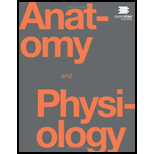
Which of the following is unique to the muscles of facial expression?
- They all originate from the scalp musculature.
- They insert onto the cartilage found around the face.
- They only insert onto the facial bones.
- They insert into the skin.
Introduction:
The muscles for facial expression are specific as they are not attached to the bones unlike the majority of the skeletal muscles. Their motion does not require movement of the bones. They arise from the surface of the skull and get presented into the skin. The muscles at the point of origin remain fixed, however, due to the movement of the skin these muscles develop facial expression.
Answer to Problem 1RQ
The correct answer is option (d) they insert into the skin.
Explanation of Solution
Explanation/justification for the correct answer:
Option (d) they insert into the skin. Facial muscles take part in facial expressions and movement. They are not same like other skeletal muscles that move with the assistance of skeleton. The movement of facial muscle takes place by pulling the skin, in the case no movement of bone takes place. The surface of the skull is the origin of the facial muscle.
The muscle fibers taking part in facial expression are administered into the dermis of the skin. With the movement of the skin, the muscles develop facial expression. So, the correct answer is option (d).
Explanation for the incorrect answer:
Option (a) they all originate from the scalp musculature. The muscles of facial expression do not originate from the scalp musculature. So, this is an incorrect option.
Option (b) they insert onto the cartilage found around the face. The given option is not relevant to the given question. So, this is an incorrect option.
Option (c) they only insert on the facial bones. The muscles involved in facial expression insert into the skin, not onto the facial bones. So, this is an incorrect option.
The muscles involved in facial expression get insert into the skin. Hence, the correct answer is option (d) they insert into the skin.
Want to see more full solutions like this?
Chapter 11 Solutions
Anatomy & Physiology
Additional Science Textbook Solutions
Chemistry: Structure and Properties (2nd Edition)
Campbell Biology: Concepts & Connections (9th Edition)
Chemistry: The Central Science (14th Edition)
Campbell Essential Biology (7th Edition)
Chemistry: A Molecular Approach (4th Edition)
Microbiology: An Introduction
- Describe the principle of homeostasis.arrow_forwardExplain how the hormones of the glands listed below travel around the body to target organs and tissues : Pituitary gland Hypothalamus Thyroid Parathyroid Adrenal Pineal Pancreas(islets of langerhans) Gonads (testes and ovaries) Placentaarrow_forwardWhat are the functions of the hormones produced in the glands listed below: Pituitary gland Hypothalamus Thyroid Parathyroid Adrenal Pineal Pancreas(islets of langerhans) Gonads (testes and ovaries) Placentaarrow_forward
- Describe the hormones produced in the glands listed below: Pituitary gland Hypothalamus Thyroid Parathyroid Adrenal Pineal Pancreas(islets of langerhans) Gonads (testes and ovaries) Placentaarrow_forwardPlease help me calculate drug dosage from the following information: Patient weight: 35 pounds, so 15.9 kilograms (got this by dividing 35 pounds by 2.2 kilograms) Drug dose: 0.05mg/kg Drug concentration: 2mg/mLarrow_forwardA 25-year-old woman presents to the emergency department with a 2-day history of fever, chills, severe headache, and confusion. She recently returned from a trip to sub-Saharan Africa, where she did not take malaria prophylaxis. On examination, she is febrile (39.8°C/103.6°F) and hypotensive. Laboratory studies reveal hemoglobin of 8.0 g/dL, platelet count of 50,000/μL, and evidence of hemoglobinuria. A peripheral blood smear shows ring forms and banana-shaped gametocytes. Which of the following Plasmodium species is most likely responsible for her severe symptoms? A. Plasmodium vivax B. Plasmodium ovale C. Plasmodium malariae D. Plasmodium falciparumarrow_forward
- please fill in missing parts , thank youarrow_forwardplease draw in the answers, thank youarrow_forwarda. On this first grid, assume that the DNA and RNA templates are read left to right. DNA DNA mRNA codon tRNA anticodon polypeptide _strand strand C с A T G A U G C A TRP b. Now do this AGAIN assuming that the DNA and RNA templates are read right to left. DNA DNA strand strand C mRNA codon tRNA anticodon polypeptide 0 A T G A U G с A TRParrow_forward
 Anatomy & PhysiologyBiologyISBN:9781938168130Author:Kelly A. Young, James A. Wise, Peter DeSaix, Dean H. Kruse, Brandon Poe, Eddie Johnson, Jody E. Johnson, Oksana Korol, J. Gordon Betts, Mark WomblePublisher:OpenStax College
Anatomy & PhysiologyBiologyISBN:9781938168130Author:Kelly A. Young, James A. Wise, Peter DeSaix, Dean H. Kruse, Brandon Poe, Eddie Johnson, Jody E. Johnson, Oksana Korol, J. Gordon Betts, Mark WomblePublisher:OpenStax College Medical Terminology for Health Professions, Spira...Health & NutritionISBN:9781305634350Author:Ann Ehrlich, Carol L. Schroeder, Laura Ehrlich, Katrina A. SchroederPublisher:Cengage Learning
Medical Terminology for Health Professions, Spira...Health & NutritionISBN:9781305634350Author:Ann Ehrlich, Carol L. Schroeder, Laura Ehrlich, Katrina A. SchroederPublisher:Cengage Learning- Lifetime Physical Fitness & WellnessHealth & NutritionISBN:9781337677509Author:HOEGERPublisher:Cengage





